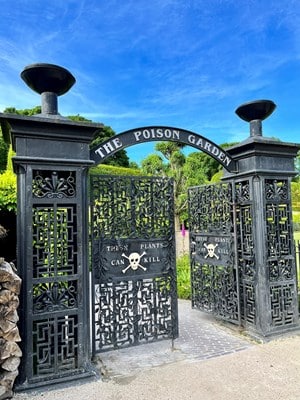A skull and crossbones sign welcomes visitors to Alnwick Gardens, they are only allowed to look but if life is dear they must not smell, touch and taste
800,000 tourists flock to Alnwick Castle in the north of Great Britain every year. Called the Versailles of the North, it attracts like a magnet not only because of its harsh and mystical beauty, but also because in its huge park it hides something irresistible for every lover of a good crime read – the deadliest garden in Europe, also known as the garden of poisons.
Just a few kilometers north of Newcastle, late 11th and early 12th century Alnwick is familiar to many from television and film because
the imposing fortress is featured in the footage of the series “Downton Manor”, as well as in two of the films about the boy wizard – “Harry Potter and the Philosopher’s Stone” and “Harry Potter and the Chamber of Secrets”.
Behind an imposing black metal fence that greets visitors with the words ‘These plants kill’, eloquently illustrated with a skull and crossbones, the poison garden is home to over 100 species from around the world that are alluringly beautiful but deadly dangerous. Jane Percy, who in 1995 became the Duchess of Northumberland after her husband inherited the title and the castle, was the author of the unusual idea. The new owner asks her to take care of the park, which until then is just a forest with neatly arranged rows of trees.
In 1996, Percy engaged Jacques Wirtz, a Belgian landscape architect credited with the renovation of the Tuileries Gardens and the Elysée Palace in Paris. He created the plans for a garden of 3,000 roses, a “snake garden” with turtle-shaped bushes, a bamboo maze, and the famous poison plant garden.
In the beginning, the duchess wanted to make a special place for medicinal herbs, but after visiting the botanical garden in Padua of the Medici family – one of the most famous poisoners of the second half of the 15th century, the idea came to her “for something really completely different”, she says she in front of “Smithsonian” magazine.
“If you decide to build something, especially a tourist attraction, you have to make it truly unique – adds the aristocrat. – One of the things I hate the most is the standardization of everything. So I thought I should do something completely unusual.”
By carefully selecting the deadly species, apart from the mandatory requirement that they can thrive on British soil,
Jane Percy insisted that each root tell its own interesting story. After all, the garden opened its doors in 2004. Thus, in it, tourists can not only see what the green killers look like, but also learn the legends and historical facts that brought them sinister fame.
“What’s amazing about toxic species is that they’re common and common in nature, but people don’t know them and don’t realize what can happen to them sometimes just by touching them,” added the Duchess. Visitors were surprised to learn, for example, that the oleander, found in many gardens, is highly poisonous.
Behind the black fence, visitors must be especially careful as they navigate through hedges of highly toxic laurel, belladonna and hemlock – swallowed by Socrates to be put to death, as well as bushes of castor, a single seed of which leads to complete rejection of all organs. Not to mention the beautiful brugmansia, or angel’s trumpet, which is the Duchess’s favorite flower.
“It is an amazing aphrodisiac that subsequently takes you to the afterlife. During the Victorian era, women would leave one of the angel’s trumpet flowers in the middle of the card table. They put their glasses under the bell, tapped it lightly so that a little bit of pollen fell into the drink. The effect was like LSD,” says Lady Percy.
Next to the strong ogres, there is also a square of drugs, where opium, cannabis, coca, hallucinogenic mushrooms grow. They are grown with a special permit so that visitors of the youngest generation can be explained their harm and the dangers they pose.
There are free guided tours of the gardens every 10-15 minutes, and the entrance ticket is €30 for adults and €12.50 for children over 5. From the end of March to the end of October, they are open until 6pm.
Gardeners who care for all these species wear special protective clothing and gloves and are required to observe a number of precautions. Guests can only look, but are absolutely forbidden to touch, smell or, God forbid, taste. The most dangerous poisons are enclosed in cages, and there is also 24/7 surveillance with cameras.
However, a few years ago an incident occurred. Youngsters managed to snatch a few oleander leaves as a souvenir. A few minutes later, the driver and passengers fall asleep under the influence of the toxic fumes from the leaves and cause a crash.
In addition to the poisonous gardens, Alnwick Castle is also known for a sinister legend. According to legends, in the Middle Ages, an ugly creature similar to vampires roamed it, because it sucked blood and spread diseases. It tormented the local people for years before they managed to kill it and bury it in the dungeons of the fortress.
PHOTO: A skull and bones sign on the black garden fence warns of the dangers lurking / Pixabay









